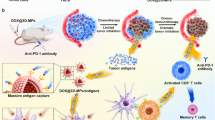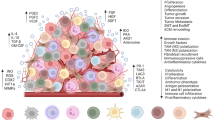Abstract
Cytotoxic T lymphocyte (CTL) can have remarkable abilities to kill tumor cells. However, the establishment of successful CTL-based anticancer therapy has met with many challenges. Within tumor cells, there exist subpopulations with low or no expression of the targeted antigen (termed as antigen-loss variants). In addition, tumor cells can downregulate the levels of major histocompatibility complex class I (MHC-I) molecules on cell surface due to immune pressure. As a result, some tumor cells can escape the immune pressure bestowed by CTLs, resulting in treatment failure. To address these difficulties, a new approach is developed to deliver foreign high-affinity CTL epitopes to tumor tissues utilizing pH-responsive “smart” microparticles (MPs). These MPs could encapsulate CTL peptide epitope, release the peptide under acidic condition encountered in tumor tissues and enhance CTL activation. Mice bearing pre-established tumor as “antigen-loss variant” solid tumor models were administered intratumorally with MPs containing the CTL peptide, which showed 100% survival following the treatment. In contrast, all control mice died from tumor. Significant protection from tumor-induced death was also observed with systemic administration of CTL peptide-MPs. The therapeutic efficacy can be attributed to enhanced delivery of the epitope to tumor tissues, presentation of the epitope by tumor cells as well as tumor stromal cells and/or generation of epitope-specific CTLs by the peptide-containing MPs. These findings offer a promising new direction for treating established solid tumor using CTL therapy.






Similar content being viewed by others
Abbreviations
- 7-AAD:
-
7-Aminoactinomycin D
- ACE-Dex:
-
Acetalated dextran
- ALV:
-
Antigen-loss variant
- CFSE:
-
Carboxyfluorescein succinimidyl ester
- CRPG:
-
Chlorophenol red-β-d-galactopyranoside
- CTL:
-
Cytotoxic T lymphocyte
- CTLp:
-
CTL peptide epitope
- DCM:
-
Dichloromethane
- DMEM:
-
Dulbecco’s modified Eagle’s medium
- DMSO:
-
Dimethyl sulfoxide
- FACS:
-
Fluorescence-activated cell sorting
- FBS:
-
Fetal bovine serum
- Fmoc:
-
Fluorenylmethyloxycarbonyl
- HBSS:
-
Hank’s balanced salt solution
- mAb:
-
Monoclonal antibody
- MHC-I:
-
Major histocompatibility complex class I
- MP:
-
Microparticle
- PBS:
-
Phosphate-buffered saline
- PE:
-
Phycoerythrin
- RPMI:
-
Roswell Park Memorial Institute
References
Melero I, Gaudernack G, Gerritsen W, Huber C, Parmiani G, Scholl S, Thatcher N, Wagstaff J, Zielinski C, Faulkner I, Mellstedt H (2014) Therapeutic vaccines for cancer: an overview of clinical trials. Nat Rev Clin Oncol 11:509–524
June CH (2007) Adoptive T cell therapy for cancer in the clinic. J Clin Invest 117:1466–1476
Klein L, Kyewski B, Allen PM, Hogquist KA (2014) Positive and negative selection of the T cell repertoire: what thymocytes see (and don’t see). Nat Rev Immunol 14:377–391
Uyttenhove C, Maryanski J, Boon T (1983) Escape of mouse mastocytoma P815 after nearly complete rejection is due to antigen-loss variants rather than immunosuppression. J Exp Med 157:1040–1052
Khong HT, Restifo NP (2002) Natural selection of tumor variants in the generation of “tumor escape” phenotypes. Nat Immunol 3:999–1005
Lakshminarayanan V, Supekar NT, Wei J, McCurry DB, Dueck AC, Kosiorek HE, Trivedi PP, Bradley JM, Madsen CS, Pathangey LB, Hoelzinger DB, Wolfert MA, Boons GJ, Cohen PA, Gendler SJ (2016) MUC1 vaccines, comprised of glycosylated or non-glycosylated peptides or tumor-derived MUC1, can circumvent immunoediting to control tumor growth in MUC1 transgenic mice. PLoS ONE 11:e0145920. doi:10.1371/journal.pone.0145920 eCollection 2016
Dunn GP, Bruce AT, Ikeda H, Old LJ, Schreiber RD (2002) Cancer immunoediting: from immunosurveillance to tumor escape. Nat Immunol 3:991–998
Ward PL, Koeppen HK, Hurteau T, Rowley DA, Schreiber H (1990) Major histocompatibility complex class-I and unique antigen expression by murine tumors that escaped from CD8+ T-cell-dependent surveillance. Cancer Res 50:3851–3858
Tlsty TD, Coussens LM (2006) Tumor stroma and regulation of cancer development. Annu Rev Pathol 1:119–150
Spiotto MT, Schreiber H (2005) Rapid destruction of the tumor microenvironment by CTLs recognizing cancer-specific antigens cross-presented by stromal cells. Cancer Immun 5:8–14
Schietinger A, Philip M, Liu RB, Schreiber K, Schreiber H (2010) Bystander killing of cancer requires the cooperation of CD4(+) and CD8(+) T cells during the effector phase. J Exp Med 207:2469–2477
Spiotto MT, Rowley DA, Schreiber H (2004) Bystander elimination of antigen loss variants in established tumors. Nat Med 10:294–298
Gao W, Chan J, Farokhzad OC (2010) pH-Responsive nanoparticles for drug delivery. Mol Pharm 7:1913–1920
Prabhakar U, Maeda H, Jain RK, Sevick-Muraca EM, Zamboni W, Farokhzad OC, Barry ST, Gabizon A, Grodzinski P, Blakey DC (2013) Challenges and key considerations of the enhanced permeability and retention effect for nanomedicine drug delivery in oncology. Cancer Res 73:2412–2417
Maeda H, Bharate GY, Daruwalla J (2009) Polymeric drugs for efficient tumor-targeted drug delivery based on EPR-effect. Eur J Pharm Biopharm 71:409–419
Tannock IF, Rotin D (1989) Acid pH in tumors and its potential for therapeutic exploitation. Cancer Res 49:4373–4384
Bilati U, Allémann E, Doelker E (2003) Sonication parameters for the preparation of biodegradable nanocapsules of controlled size by the double emulsion method. Pharm Dev Technol 8:1–9
Bachelder EM, Beaudette TT, Broaders KE, Dashe J, Frechet JMJ (2008) Acetal-derivatized dextran: an acid-responsive biodegradable material for therapeutic applications. J Am Chem Soc 130:10494–10495
Tomayko MM, Reynolds CP (1989) Determination of subcutaneous tumor size in athymic (nude) mice. Cancer Chemother Pharmacol 24:148–154
Apostolopoulos V, Haurum JS, McKenzie IF (1997) MUC1 peptide epitopes associated with five different H-2 class I molecules. Eur J Immunol 27:2579–2587
Eisen HN, Hou XH, Shen C, Wang K, Tanguturi VK, Smith C, Kozyrytska K, Nambiar L, McKinley CA, Chen J, Cohen RJ (2012) Promiscuous binding of extracellular peptides to cell surface class I MHC protein. Proc Natl Acad Sci USA 109:4580–4585
Karttunen J, Shastri N (1991) Measurement of ligand-induced activation in single viable T cells using the lacZ reporter gene. Proc Natl Acad Sci USA 88:3972–3976
Ke Y, Li Y, Kapp JA (1995) Ovalbumin injected with complete Freund’s adjuvant stimulates cytolytic responses. Eur J Immunol 25:549–553
Durward M, Harms J, Splitter G (2010) Antigen specific in vivo killing assay using CFSE labeled target cells. J Vis Exp. doi:10.3791/2250
Breart B, Lemaître F, Celli S, Bousso P (2008) Two-photon imaging of intratumoral CD8+ T cell cytotoxic activity during adoptive T cell therapy in mice. J Clin Invest 118:1390–1397
Shao K, Singha S, Clemente-Casares X, Tsai S, Yang Y, Santamaria P (2015) Nanoparticle-based immunotherapy for cancer. ACS Nano 9:16–30
Kang TH, Knoff J, Yang B, Tsai Y-C, He L, Hung C-F, Wu TC (2013) Control of spontaneous ovarian tumors by CD8+ T cells through NKG2D-targeted delivery of antigenic peptide. Cell Biosci 3:48
Song L, Yang MC, Knoff J, Sun ZY, Wu TC, Hung CF (2014) Cancer immunotherapy using a potent immunodominant CTL epitope. Vaccine 32:6039–6048
Kanzaki M, Okamoto T, Mitsui H, Shibagaki N, Shimada S (2010) A novel immunotherapeutic approach to melanoma-bearing hosts with protein-transduction domain-containing immunogenic foreign antigens. J Dermatol Sci 60:84–94
Lee YH, Yoon HY, Shin JM, Saravanakumar G, Noh KH, Song KH, Jeon JH, Kim DW, Lee KM, Kim K, Kwon IC, Park JH, Kim TW (2015) A polymeric conjugate foreignizing tumor cells for targeted immunotherapy in vivo. J Control Release 199:98–105
Fosgerau K, Hoffmann T (2015) Peptide therapeutics: current status and future directions. Drug Discov Today 20:122–128
Varna M, Ratajczak P, Ferreira I, Leboeuf C, Bousquet G, Janin A (2012) In vivo distribution of inorganic nanoparticles in preclinical models. J Biomater Nanobiotechnol 3:269–279
Cohen JA, Beaudette TT, Cohen JL, Brooders KE, Bachelder EM, Frechet JMJ (2010) Acetal-modified dextran microparticles with controlled degradation kinetics and surface functionality for gene delivery in phagocytic and non-phagocytic cells. Adv Mater 22:3593–3597
Peine KJ, Guerau-de-Arellano M, Lee P, Kanthamneni N, Severin M, Probst GD, Peng H, Yang Y, Vangundy Z, Papenfuss TL, Lovett-Racke AE, Bachelder EM, Ainslie KM (2014) Treatment of experimental autoimmune encephalomyelitis by codelivery of disease associated peptide and dexamethasone in acetalated dextran microparticles. Mol Pharm 11:828–835 and references cited therein
Suarez S, Grover GN, Braden RL, Christman KL, Amutairi A (2013) Tunable protein release from acetalated dextran microparticles: a platform for delivery of protein therapeutics to the heart post-MI. Biomacromolecules 14:3927–3935
Feltkamp MC, Smits HL, Vierboom MP, Minnaar RP, De Jongh BM, Drijfhout JW, Ter Schegget J, Melief CJ, Kast WM (1993) Vaccination with cytotoxic T lymphocyte epitope-containing peptide protects against a tumor induced by human papillomavirus type 16-transformed cells. Eur J Immunol 23:2242–2249
Vitiello A, Ishioka G, Grey HM, Rose R, Farness P, LaFond R, Yuan L, Chisari FV, Furze J, Bartholomeuz R, Chesnut RW (1995) Development of a lipopeptide-based therapeutic vaccine to treat chronic HBV infection. I. Induction of a primary cytotoxic T lymphocyte response in humans. J Clin Invest 95:341–349
Wherry EJ, Ahmed R (2004) Memory CD8 T-cell differentiation during viral infection. J Virol 78:5535–5545
Pardoll DM (2012) The blockade of immune checkpoints in cancer immunotherapy. Nat Rev Cancer 12:252–264
Acknowledgements
We are grateful to the National Cancer Institute (R01CA149451) for financial support of this work. We would like to thank Prof. Olivera J. Finn (University of Pittsburgh) for helpful suggestions.
Author information
Authors and Affiliations
Corresponding author
Ethics declarations
Conflict of interest
The authors have no conflicts of interest to declare.
Ethical approval
All applicable international, national, and/or institutional guidelines for the care and use of animals were followed. All animal care procedures and experimental protocols performed were in accordance with the ethical standards and have been approved by the Institutional Animal Care and Use Committee (IACUC) of Michigan State University.
Additional information
Herbert W. Kavunja and Shuyao Lang have contributed equally to this work.
Electronic supplementary material
Below is the link to the electronic supplementary material.
Rights and permissions
About this article
Cite this article
Kavunja, H.W., Lang, S., Sungsuwan, S. et al. Delivery of foreign cytotoxic T lymphocyte epitopes to tumor tissues for effective antitumor immunotherapy against pre-established solid tumors in mice. Cancer Immunol Immunother 66, 451–460 (2017). https://doi.org/10.1007/s00262-016-1948-9
Received:
Accepted:
Published:
Issue Date:
DOI: https://doi.org/10.1007/s00262-016-1948-9




